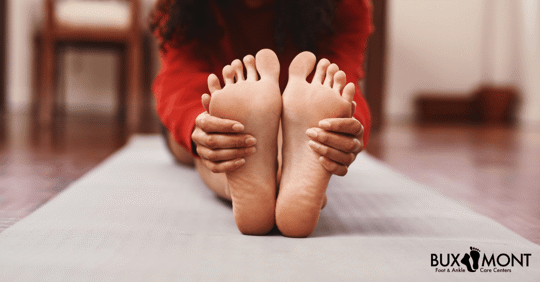Aren’t My Feet Always Flat?
While technically, your feet lie flat against smooth surfaces like the floor, they should have a slight arch in between the balls of your feet and your heels. The purpose of the arch of your foot is to maintain balance in the body. Your arches are actually responsible for putting a spring in your step!
However, some people have fallen arches, also known as being flat-footed.
What Are Flat Feet?
Flat feet occur when the arches of your foot depress, allowing the entire sole of your foot to touch the ground. This condition is commonly found in both feet; however, at times, it can be in just one foot. Being flat-footed can be painful and can also lead to tension in your muscles, ligaments, and tendons due to the feet not being properly supported. This can cause further complications such as balance issues and the misaligning of other body parts.
What Causes Flat Feet?
The cause of flat feet is a change in the tendon that typically supports the foot’s arch and provides support. However, there are numerous causes for the degeneration of this tendon. Injuries, obesity, arthritis, and aging are all possible factors. Genetics, pregnancy, and disease can also contribute to this condition.
Babies are naturally born with flat feet, which persists into their childhood. Children typically develop their arch around the age of 6, but sometimes they never develop at all. People diagnosed with a neurological or muscular disorder such as cerebral palsy, muscular dystrophy, or spina bifida, are more prone to having flat feet.
Treating Flat Feet
Treating your flat feet can help realign your entire body. It is important to treat them properly to reduce and prevent pain or other imbalances. While completing the following exercises, concentrate on strengthening and lengthening your arches for the most effective results.
1. Heel Stretches
To complete a proper heel stretch, stand with your hands resting on a wall, chair, or some form of support. Place one leg in front of you, pressing both heels firmly into the floor. Keeping your back leg straight, bend your front knee, and push yourself into the wall for resistance. You should feel this stretch in the back of your leg and Achilles tendon.
There are a few things to keep in mind while completing this stretch. First, make sure to keep your spine as straight as possible. Secondly, remember that the more you bend your front leg, the deeper the stretch will be. Do not over-stretch yourself past your pain threshold. It should only stretch the muscles, not cause pain!
Hold this position for 30 seconds each and repeat the exercise four times per side.
2. Tennis Balls
For this exercise, you will need props! Grab a tennis or golf ball and a chair. While seated, place the tennis or golf ball under your foot. Sit up straight and roll the ball underneath your foot, focusing on the arch.
If placing the right amount of pressure on the ball, this exercise will help loosen your plantar fascia. Do this for two to three minutes per foot to benefit from this exercise. Do not continue the exercise if it causes any pain; however, you can expect some mild soreness.
3. Calf Raises
Calf raises are helpful for flat feet because by stretching and strengthening your calves, you are also stretching the plantar fascia and Achilles tendon. Overall, this should reduce any pain you may be experiencing.
To complete calf raises, stand tall and plant both feet firmly into the ground. If necessary, use a wall or chair to help support your balance. Then begin to lift your heels as high as possible, placing most of your weight onto your toes.
Hold the calf raises for 5 seconds at the top before lowering your feet back to the ground. Repeat this 15-20 times, depending on your comfort level. Then, repeat each set 2-3 times.
After completing your calf raises, hold the position at the top and then pulse up and down for 30 seconds for an extra challenge.
4. Contact a Podiatrist
At Bux-Mont Foot & Ankle Care Centers, our certified podiatrists are there to improve your life one step at a time. If you are experiencing chronic foot pain, contact us online or call our office at (215) 392-4009.

